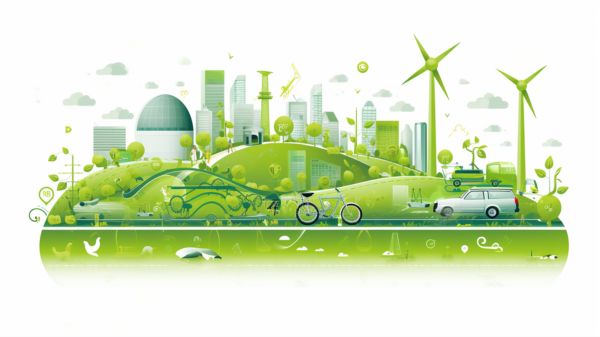Are you searching for the most energy-efficient transportation options? Look no further! In this article, we’ll compare electric cars, hybrid vehicles, public transportation, cycling and walking, and carpooling and ride-sharing.
By analyzing the data, we aim to help you make an informed choice while considering your impact on the environment. So, whether you’re a conscientious commuter or an eco-conscious traveler, join us as we delve into the world of green transportation and find the perfect fit for you.
Electric Cars
When considering green transportation options, electric cars offer a highly energy-efficient solution. Electric vehicles (EVs) are powered by electricity stored in rechargeable batteries, eliminating the need for gasoline or diesel fuel. This not only reduces greenhouse gas emissions and air pollution but also decreases our dependence on fossil fuels.
In terms of environmental impact, EVs have the potential to significantly decrease carbon dioxide emissions compared to traditional internal combustion engine vehicles. However, the widespread adoption of electric cars is dependent on the availability of charging infrastructure.
To support the growth of EVs, it’s crucial to develop a robust network of charging stations that are easily accessible to the public. By investing in charging infrastructure, we can encourage more people to switch to electric vehicles and contribute to a cleaner and greener future.
Hybrid Vehicles
To increase energy efficiency, consider choosing hybrid vehicles. These vehicles are designed to combine the benefits of both gasoline and electric power, resulting in improved fuel economy and reduced emissions.
When comparing hybrid vehicles, there are several factors to consider:
- Fuel economy: Hybrid vehicles use a combination of gasoline and electric power, allowing them to achieve higher fuel efficiency compared to traditional gasoline cars. This means you can save money on fuel costs and reduce your carbon footprint.
- Battery technology: Hybrid vehicles utilize advanced battery technology to store energy and power the electric motor. The development of lightweight and high-capacity batteries has greatly improved the performance and range of hybrid vehicles, making them even more efficient and practical for everyday use.
- Regenerative braking: Hybrid vehicles employ regenerative braking technology, which allows the vehicle to convert kinetic energy into electricity and store it in the battery. This energy can then be used to power the electric motor, further enhancing fuel efficiency.
Public Transportation
Consider using public transportation as a means to further increase your energy efficiency and reduce emissions, while benefiting from the convenience and accessibility it offers.
Investing in an efficient public transportation system brings various benefits. Firstly, it reduces traffic congestion, leading to shorter travel times and decreased fuel consumption. Additionally, public transportation reduces the number of cars on the road, resulting in lower greenhouse gas emissions and improved air quality.
Strategies for increasing public transportation ridership and reducing car dependency include expanding and improving public transit networks, implementing affordable fares, and providing convenient schedules. Encouraging active transportation modes such as walking and cycling can also complement public transportation and further reduce car usage.
Cycling and Walking
Embracing cycling and walking as modes of transportation enhances energy efficiency and promotes sustainable mobility. Not only are these methods of transportation environmentally friendly, but they also offer numerous health benefits. Here are a few reasons why incorporating cycling and walking into your daily routine is a smart choice:
- Sustainable Infrastructure:
- Dedicated bike lanes and pedestrian-friendly pathways are essential components of sustainable infrastructure.
- Investing in these infrastructure improvements encourages more people to choose cycling and walking as viable transportation options.
- It reduces the reliance on cars, leading to reduced greenhouse gas emissions and congestion.
- Health Benefits:
- Regular cycling and walking provide excellent cardiovascular exercise, improving heart health and reducing the risk of heart disease.
- These activities also help maintain a healthy weight, strengthen muscles, and improve overall fitness levels.
- Cycling and walking can also have positive mental health benefits, reducing stress and improving mood.
Carpooling and Ride-Sharing
When it comes to promoting energy efficiency and reducing carbon emissions, carpooling and ride-sharing offer a convenient and eco-friendly alternative to single-occupancy vehicles. Not only do they help reduce traffic congestion, but they also have a positive environmental impact.
By sharing a ride with others, you can significantly reduce the number of vehicles on the road, leading to lower fuel consumption and greenhouse gas emissions. According to a study conducted by the University of California, carpooling can reduce carbon emissions by up to 20%.
Additionally, carpooling and ride-sharing can lead to significant cost savings. By splitting fuel costs and toll fees with other passengers, you can save money on transportation expenses. According to the American Public Transportation Association, carpooling can save an individual up to $1,000 per year.
Conclusion
In the race for green transportation, electric cars take the lead as the most energy-efficient option, symbolizing the future of sustainable mobility. With their efficient electric motors and regenerative braking systems, electric cars offer the highest energy efficiency among the options discussed.
Hybrid vehicles follow closely behind, combining the best of both worlds.
Public transportation, cycling and walking, as well as carpooling and ride-sharing, all play crucial roles in reducing emissions and promoting sustainable transportation choices.




